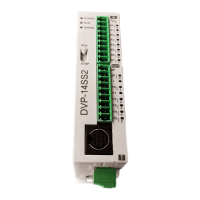DVP-ES2/EX2/EC5/SS2/SA2/SX2/SE&TP Operation Manual - Programming
-220
. PLC reads the current counter value.
. Drop the counter value: the number of filters read is less than the number of filters set.
. Record the counter value: the signal is high (ON time) and records the counter value to the
comparing stack area for entering.
. Record the counter value: the signal is low (OFF time) and records the counter value to the
comparing stack area for leaving.
. Unsettled pulse section
13. When the signal is rising- or falling-edge triggered, and the PLC completes processing the
filters, the PLC reads the high-speed counter value and adds one in the value of the head
index. The PLC then records the entering and leaving counter results for each work station.
The compared counter result is the current counter value + reference value + observational
error. For either rising- or falling-edge triggered, the value of the head index is incremented.
The maximum value for the head index mx2 (the maximum number of objects).
14. The value of the head index is cyclically incremented, when the signal is rising- or falling-edge
triggered and completes processing the number of filters (the default for trigger input is OFF).
The maximum value for the head index is mx2 (the maximum number of objects). For example,
if you set the number of objects to 10, the value of the head index (default: 0) is incremented to
1, 2, 3 to 20 and then 1, 2, 3 to 20 repeatedly. When the value of the head index is 0, it means
no object has entered after executing the instruction. The PLC adds one to the value of the
head index, and then checks the value of the tail index. If the value (after adding one) in the
value of the head index equals the value of the tail index, the PLC cancels the addition and
records the counter result.
15. When the instruction is executed and the state of the initial input is OFF, the rising-edge
trigger corresponds to the odd numbers of the head index value, and the falling-edge
trigger corresponds to the even numbers of the head index value.
16. When the PLC executes the instruction and the state of the initial input is ON, the falling-edge
trigger corresponds to the odd numbers of the head index value, and the rising-edge
trigger corresponds to the even numbers of the head index value.
17. When the PLC executes the instruction, it does not clear the values in the accumulated area
and the index areas. If the data is in a latched area and needs to be enabled again, use the
ZRST instruction to clear the values in the head and tail indexes.

